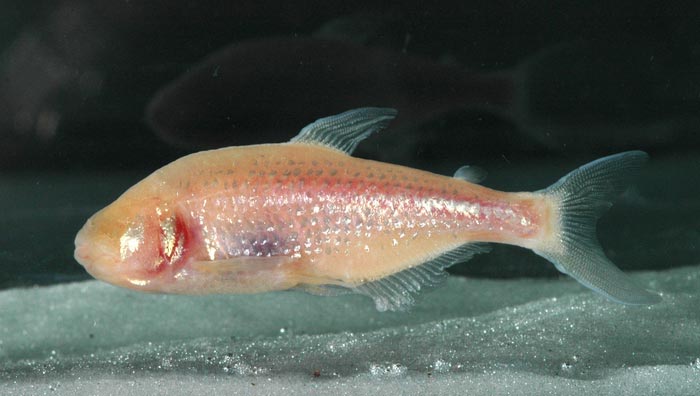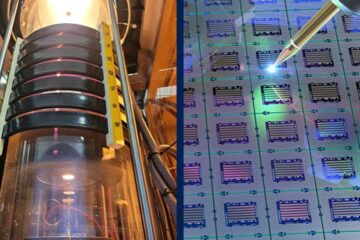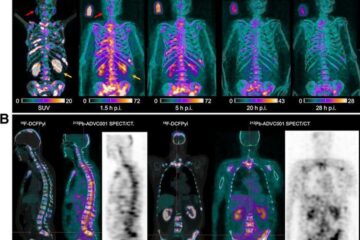Scientists find new variations among sperm cells

Male Astyanax mexicanus (blind cave fish)
Credit: Richard Borowsky, New York University
Research offers additional insights into the reproductive process.
The behavior of sperm cells is due, in part, to the individual DNA make-up of these cells, rather than only to the genetics of males, finds a team of scientists. Its results, which provide a new understanding of the competition among sperm cells to fertilize the egg, have larger implications for the reproductive process.
The study, which centers on the swimming behavior of sperm cells, is the first to establish a direct effect of mutation on sperm behavior and suggests that the development and application of screens based on sperm behavior can improve the quality of the genetics they carry.
“Until now, the predominant view was that this variation in swimming behavior reflected the overall genetics of the male rather than the variable genetics of the individual sperm cells,” explains Richard Borowsky, a professor emeritus in NYU’s Department of Biology and the senior author of the paper, which appears in the journal Scientific Reports. “This study is the first to demonstrate that genetic differences can directly affect the swimming behavior of sperm cells.”
This fuller grasp, he adds, may offer additional knowledge on the impact of abnormal sperm cells on offspring, notably birth defects.
The work , which included Haining Chen, an NYU graduate student at the time of the study and now at Westlake University in Hangzhou, China, focused on sperm cells in male fish—specifically Astyanax mexicanus cave fish. It compared the sperm cells in normal fish with those of fish whose sperm production had been artificially mutated. This allowed the scientists to identify behavioral and morphological characteristics potentially altering the sperm’s chances in the race to fertilize the egg.
Their results showed no difference in flagellar length— the hair-like appendage that propels them as they swim towards the egg—between the normal and mutated samples. However, there was greater variability in the velocity, or swimming speed, of the mutated samples compared to the normal ones—meaning that in many instances, the mutated samples swam at lower and faster speeds than did normal ones. Overall, while both types of sperm cells appeared similar, their behaviors are quite different and at crucial stages.
The findings offer additional insights into the nature of reproduction.
It’s been long established that sperm from different males vary in their characteristics because of the genetic differences between the males. This study established that different sperm from the same male vary in their characteristics because they differ in their genetic cargo.
Journal: Scientific Reports
DOI: 10.1038/s41598-022-22486-5
Method of Research: Experimental study
Subject of Research: Animals
Article Title: Mutagenesis alters sperm swimming velocity in Astyanax cave fish
Article Publication Date: 15-Nov-2022
Media Contact
James Devitt
New York University
james.devitt@nyu.edu
Office: United States
Cell: 914-522-3774
All latest news from the category: Life Sciences and Chemistry
Articles and reports from the Life Sciences and chemistry area deal with applied and basic research into modern biology, chemistry and human medicine.
Valuable information can be found on a range of life sciences fields including bacteriology, biochemistry, bionics, bioinformatics, biophysics, biotechnology, genetics, geobotany, human biology, marine biology, microbiology, molecular biology, cellular biology, zoology, bioinorganic chemistry, microchemistry and environmental chemistry.
Newest articles

Silicon Carbide Innovation Alliance to drive industrial-scale semiconductor work
Known for its ability to withstand extreme environments and high voltages, silicon carbide (SiC) is a semiconducting material made up of silicon and carbon atoms arranged into crystals that is…

New SPECT/CT technique shows impressive biomarker identification
…offers increased access for prostate cancer patients. A novel SPECT/CT acquisition method can accurately detect radiopharmaceutical biodistribution in a convenient manner for prostate cancer patients, opening the door for more…

How 3D printers can give robots a soft touch
Soft skin coverings and touch sensors have emerged as a promising feature for robots that are both safer and more intuitive for human interaction, but they are expensive and difficult…





















